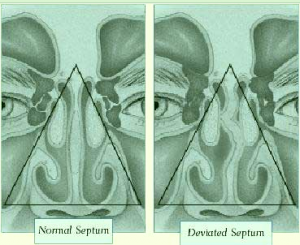A deviated septum is formed when the nasal septum or the thin wall between the nostrils is dislocated to one side. The septum divides the left and the right cavities of the nose and is typically located in the center of the nose, causing equal division of the two sides. However, several people experience displacement of the nasal septum, thereby making one nasal passage smaller than the other.
Severe cases of a deviated septum can obstruct one side of the nasal passage, thereby decreasing the flow of air and resulting in nosebleeds, breathing problems and other signs.
Nasal blockages can be treated via adhesive strips or medications to alleviate the symptoms. However, a deviated septum can only be corrected by surgical intervention.
Deviated Septum symptoms
A majority of the septal defects do not cause any signs or symptoms and most individuals with a deviated septum may not even be aware of its presence. However, certain septal abnormalities may result in the below listed symptoms:
- Nosebleeds: The wall of the nasal septum may experience dryness, thereby increasing the vulnerability to nosebleeds
- Blockage of both or one of the nostrils: Obstruction of the nostrils can pose problems in breathing via one or both nostrils. This is increasingly visible when affected individuals develop an infection of the upper respiratory tract, a cold or have allergies which lead to swelling and narrowing of the nasal passages.
- Pain in the face: If the nasal septum comes into contact with the outer surface of the nose, then the individual with a deviated septum may experience facial pain
- Noisy and loud breathing while sleeping: This symptoms if commonly found to occur in young children and infants with a deviated septum
- Repeated or frequent sinus infections: Sinus infections may be caused due to clogged mucus and are typically characterized by nasal congestion, pain in the face and a smelly discharge.

Causes of deviated septum
A deviated septum is generally caused due to displacement of the nasal septum to one side. It can result due to the following reasons:
- As a congenital condition: In certain instances, a deviated septum may develop during growth of the fetus and can be noticeable at birth
- Trauma to the nose: The nasal septum may also become dislocated as a result of an injury, eventually leading to occurrence of a deviated septum. Infants may experience such a trauma at the time of delivery. A wide range of injuries and accidents can cause a nose trauma and a deviated septum in children and adults, which include collision with another individual on the road or the sidewalk, tripping on the staircase, etc. However, it may be noted that nose injuries often result from vehicle accidents, roughhousing or active play or while playing contact sports.
- The wear and tear associated with normal aging of an individual may also lead to deterioration of the nasal tip cartilage, and thus aggravating a case of deviated septum over a period of time.
Treatment
The treatment of a deviated septum may be initially aimed at managing the symptoms of the disorder, like postnasal discharge and nasal blockage. The following medications are usually prescribed:
- Decongestants which are available in the form of nasal sprays or a pill are used to alleviate the nasal congestion and facilitate easy breathing from both nasal passages.
- Nasal steroid sprays aid in reduction of the inflammation and thus avoid a runny nose.
- Antihistamines may be suggested to reduce the allergy symptoms and prevent cold
Deviated Septum Surgery and Recovery
Severe cases of a deviated septum are repaired via a surgical procedure called septoplasty which involves reposition of the nasal septum to the center of the nose. The surgery is typically conducted in an outpatient setting with general or local anesthesia. The surgeon will cut and take of parts of the septum before rejoining it in the correct position.
As per the quantity of repair work that is required, corrective surgery of a deviated septum may take 60 to 90 minutes and the patient can go home in 3 to 4 hours post septoplasty. Soft packing substances or internal splints may be placed in the nose to steady the septum during the healing period.
The seriousness of the condition also plays an important role in the recovery and improvement of a deviated septum post surgery. Most symptoms like nasal blockage and nosebleeds generally resolve fully, but sinus disorders like allergies cannot be cured via surgery.
In certain cases, a rhinoplasty, which is a surgery to reshape the nose, is simultaneously performed along with septoplasty. There is typically no bruising or swelling post a septoplasty. However, if it is conducted along with a rhinoplasty, then it is normal to experience bruising and swelling for up to two weeks post surgery.
Deviated Septum Surgery Cost
The cost of surgery for repairing a deviated septum varies as per the different factors that are involved, such as the expertise of the surgeon, the location of the clinic, etc. Each individual case is studied separately and the costs therein involved are calculated separately as well.
However, the average cost of a septoplasty ranges from $2000 to $3500. It is important to note that corrective surgery of a deviated septum is covered by most insurance companies, but cosmetic surgery, i.e. rhinoplasty, may not be covered by them. Also, a rhinoplasty will feature an additional cost as will the initial medications to treat the symptoms.
very good put up, i certainly love this web site, carry on it